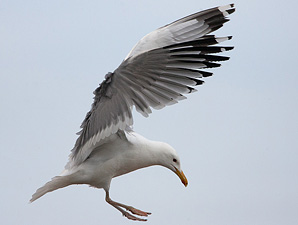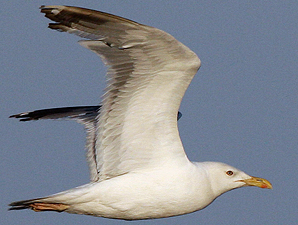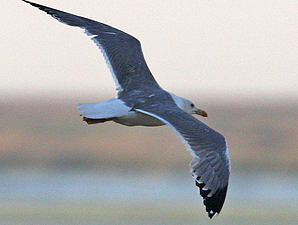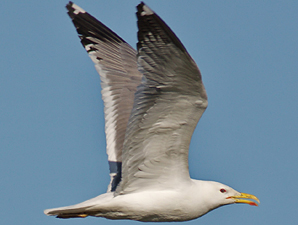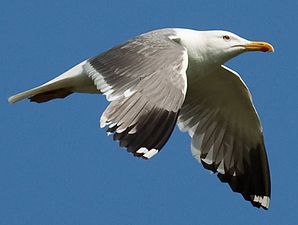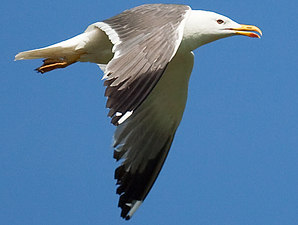 Larus cachinnans
Larus cachinnans
(last update:
Greg Neubauer
Marcin Przymencki
Albert de Jong
Mars Muusse
 sub-adult cachinnans: November
sub-adult cachinnans: November
In 2011, Chris Gibbins, Grzegorz Neubauer and Brian Small published two extensive papers in Britsih Birds, dealing with Caspian Gull. Below, you will find the content of the second paper "phenotypic variability and the field characteristics of hybrids".
The full title reads: From the Rarities Committee's files - Identification of Caspian Gull. Part 2: phenotypic variability and the field characteristics of hybrids, by Chris Gibbins, Grzegorz Neubauer and Brian Small, IN: BB 104/2011. ORDER PAPER COPY!
"we" in the text below refers to the original authors. If any errors occur in this text, please let me know and mail to marsmuusseatgmaildotcom.
PART 1: ABSTRACT & INTRODUCTION
PART 2: APPROACH
PART 3: ADULT BIRDS AND FIRST WINTER BIRDS
PART 4: DATA ANALYSIS
PART 5: VARIABILITY IN PLUMAGE (OF ADULTS)
PART 6: IDENTIFICATION OF FIRST WINTER BIRDS
PART 7: VARIABILITY IN EXTENT OF POST-JUVENILE MOULT
PART 8: UNDERWING PATTERN
PART 9: DISCUSSION
PART 10: KNOWLEDGE GAPS 1-3
PART 11 OF THE PAPER BELOW ON THIS PAGE
PART 12: KEY FINDINGS & APPENDICES
Identification of Caspian Gull. Part 2: phenotypic variability and the field characteristics of hybrids
Knowledge gaps
4. Geographic variability and hybridisation in areas of overlap
There is discussion in the literature about the geographic variability of Caspian Gull (summarised in Malling Olsen & Larsson 2003) but little or no published quantitative data on the subject. So-called “eastern” Caspian Gulls reportedly have more black and less white in the wing-tip than western birds and so potentially complicate interpretation of the wing-tip trait scores presented here. The relatively invariant P10 pattern found in our Caspian sample (less black than white on P10) refers to western, ponticus-type birds. Despite statements in the literature, Caspian Gulls observed by us farther east on the breeding grounds have shown the same P10 pattern, with a whitish and deep tongue, pure white tip and less black than white, indicating stability of the basic characters of P10. During visits to southeast European Russia and southwest Siberia (May-June 2010), Caspian Gulls were found breeding in colonies along with birds phenotypically identical to “Steppe Gulls” Larus [cachinnans] barabensis; some intermediate individuals were also observed and photographed (GN unpubl. data). Presumed mixed colonies were reported from southern Siberia some years ago (Panov & Monzikov 2000). This evidence suggests that Steppe Gull is expanding its breeding range westwards and that hybridisation with Caspian is already taking place (Filchagov 1996). As a consequence of hybridisation, “eastern Caspian Gulls” with blacker wing-tips could in fact be yet another type of hybrid - between Caspian and Steppe Gulls. The influence of the latter is likely to be expressed, for example, in more black in the wing-tips of otherwise Caspian-like birds, as was observed in Siberia in 2010. Clearly, gull studies in SE Europe and western Asia are badly needed to resolve the complex relationships between these taxa.
Much of the evidence for hybridization between Caspian and Yellow-legged Gulls comes from Poland, where they now breed in a number of mixed colonies (Neubauer et al. 2006, 2009; Beran et al. 2010). However, the evidence from Poland is rather different from that from other areas of overlap (e.g. the Black Sea coast of Romania), where these species apparently do not hybridise (Klein & Buchheim 1997; Neubauer et al. 2010). There are other areas of potential overlap between these species, notably along the eastern and southeast shoreline of the Black Sea, and our understanding of the relations between Caspian and Yellow-legged Gulls would benefit from work there. The Black Sea is further interesting because the more easterly populations of Yellow-legged Gull found there appear to differ in a number of respects from western ones, including some traits that make them more similar to Caspian Gulls (e.g. more frequently a fully white tip to P10 and a longer tongue than on western birds). There remains scope for work describing quantitatively the plumage traits of eastern Yellow-legged Gulls so that the extent to which they overlap with those of other species or hybrids can be established.
5. Call and posture
Long call and long-call posture are important in the identification of Caspian Gull (details in Gibbins et al. 2010). However, there are no published data on the call or call posture of hybrids. Consequently, work is needed to determine what hybrids sound like and the posture they adopt when long-calling. Sonogram analysis, as used for example to assess the songs of Common Chiffchaff Phylloscopus collybita, Iberian Chiffchaff P. ibericus and suspected hybrids, would most likely prove insightful (Collinson & Melling 2008).
Acknowledgments
Our sincere thanks go to Armin Deutsch, who supported us with extremely rich photographic material; many of his excellent photographs could not be printed here due to space limitations. Thanks also to the other photographers (Ruud Altenburq. Marco Basso, Alan Dalton, Tomasz Iciek, Hannu Koskinen, Lars Adler Krogh, Magdalena Zagalska-Neubauer, Visa Rauste, Michal Rycak and Marcin Sidelnik) for allowing us to use their photographs. We have benefited greatly from conversations and time in the field with birders who have been happy to share their knowledge of Caspian, Herring and Yellow-legged Gulls. In this regard, we thank Ruud Altenburg, Albert Cama, Hannu Koskinen, Mars Muusse, Theo Muusse, Joan Obiol and Visa Rauste. Four reviewers provided helpful comments that improved the manuscript.
Urszulin (near Zabrodzie), Włodawa County, Lublin Voivodeship (51.4342N 23.2285E). Recorded on 2012-03-12 by: Jarek Matusiak. Colony about 32 Pairs; some birds can be hybrids among L. cachinans and L. michahellis. |
|
Góra Kalwaria (near Podłęcze), Piaseczno County, Masovian Voivodeship (52.0312N 21.2262E). Recorded on 2013-02-26 by: Jarek Matusiak. Response on White-tailed Eagle; colony of about 83 pairs; some birds can be hybrids among L. cachinnans and L. michahellis. At least 3 L. michahellis were present, and one L. f. intermedius (but silent). |
|
Rødvig havn (55.2528N 12.3737E). Recorded on 2009-10-31 by: Lars Krogh. Begging 1st winter bird. Background gulls are some L. argentatus and L. fuscus. |
References
Bell, D. A. I997. Hybridization and reproductive performance in gulls of the Larus glaucescens-occidentalis complex. The Condor 99: 585-594.
Beran, V, Neubauer, G., & Zagalska-Neubauer, M. 2010. Prvni prokazany vyskyt zpetného krezence racka stribritého (Larus argentatus) a racka belohlavého (Larus cachinnans) v Ceské republice. [First proven case of a backcross hybrid between the Herring Gull (Larus argentatus) and the Caspian Gull (Larus cachinnans) in the Czech Republic.] Sylvia 46: 17l-l77. [In Czech with English summary]
Collinson, J. M., & Melling, T, 2008. Identification of vagrant Iberian Chiffchaffs - pointers, pitfalls and problem birds. Brit. Birds 101: 174-188.
Filchagov, A. 1996. Colonisation of the southern part of the East-European plain by Larus argentatus-cachinnans. Ibis 138: 148-150.
Gay, L., Neubauer, G., Zagalska-Neubauer, M., Debain, C., Pons, J-M., David, P, & Crochet, P-A. 2007. Molecular and morphological patterns of introgression between two large white-headed gull species in a zone of recent secondary contact. Mol. Ecol. 16: 3215-3227.
Gibbins, C., Small, B. J., & Sweeney J. 2010. Identification of Caspian Gull. Part I typical birds. Brit. Birds l03: 142-183.
Good, T. P., Ellis, J. C., Annett, C. A., & Pierotti, R. 2000. Bounded hybrid superiority in an avian hybrid zone: effects of mate, diet, and habitat choice. Evolution 54: 1774-1783.
Klein, R., & Buchheim, A. 1997. Die westliche Schwarzmeerkuste als kontaktgebiet zweier GroBmowenformen der Larus cachinnans-Gruppe. Vogelwelt 118: 61-70.
Liebers, D., de Knijff P, & Helbig, A. 2004. The Herring Gull complex is not a ring species. Proc. Roy Soc. Lond. 271: 893-901.
Malling Olsen, K., & Larsson, H. 2003. Gulls of Europe, Asia and North America. Poysen London.
Neubauer G., Betleja, I., & Zagalska-Neubauer, M., 2007. The origin of ‘Caspian Gulls’ breeding in Poland. Brit. Birds l00: 552-554.
-, Faber M., & Zagalska-Neubauer M. 2010. Yellow-legged Gulls in Poland: status and separation from yellow-legged Herring Gulls and hybrids. Dutch Birding 32: 163-l70.
-, Zagalska-Neubauer, M., Gwiazda, R., Faber M., Bukacinski, D., Betleja, J., & Chylarecki, P., 2006. Breeding large gulls in Poland: distribution, numbers, trends and hybridisation. Vogelwelt 127: 11-22.
-, -, Pons, J-M., Crochet, P-A., Chylarecki, P., Przystalski, A., & Gay L.. 2009. Assortative mating without complete reproductive isolation in a zone of recent secondary contact between Herring Gulls (Larus argentatus) and Caspian Gulls (L. cachinnans). Auk 126:409-419.
Panov, E. N., & Monzikov, D. G. 2000. Status of the form barabensis within the ‘Larus argentatus-cachinnans-fuscus complex’. Brit. Birds 93: 227-241.
Price, T., 2008. Speciation in Birds. Roberts, Colorado.
Zuur A. F., leno, E. N., & Smith, G. 2007. Analysing Ecological Data. Springen New York.
Chris Gibbins, 2 The Steadings, Newtyle Farm, Drums, Aberdeenshire AB41 6AS;
Grzegorz Neubauer, Ornithological Station, Museum and Institute of Zoology Polish Academy of Sciences, Nadwislanska 108, 80-680 Gdansk, Poland
Brian J. Small, 78 Wangford Road, Reydon, Southwold, Sufffolk IP18 6NX
END OF PART 11
CONTINUE PART 12: KEY FINDINGS & APPENDICES
 Larus cachinnans 2CY-4CY PHNN December 2012 - November 2014, the Netherlands.
Picture: Merijn Loeve, Jan Jacob de Vries, Albert de Jong, Dave van der Poel & Theo Muusse.
Larus cachinnans 2CY-4CY PHNN December 2012 - November 2014, the Netherlands.
Picture: Merijn Loeve, Jan Jacob de Vries, Albert de Jong, Dave van der Poel & Theo Muusse. Larus cachinnans 1CY-2CY PLVE December 2012 - November 2015, Utrecht & Amsterdam, Noordzee, Terschelling, the Netherlands.
Larus cachinnans 1CY-2CY PLVE December 2012 - November 2015, Utrecht & Amsterdam, Noordzee, Terschelling, the Netherlands.  Larus cachinnans hybrid 4cy 8L9B 20 November 2012, Utrecht, the Netherlands. Picture: Herman Bouman.
Larus cachinnans hybrid 4cy 8L9B 20 November 2012, Utrecht, the Netherlands. Picture: Herman Bouman. Larus cachinnans sub-adult, November 03 2007, Westkapelle, the Netherlands. Picture: Ies Meulmeester.
Larus cachinnans sub-adult, November 03 2007, Westkapelle, the Netherlands. Picture: Ies Meulmeester. Larus cachinnans sub-adult, November 13 2012, Barneveld, the Netherlands. Picture: Maarten van Kleinwee.
Larus cachinnans sub-adult, November 13 2012, Barneveld, the Netherlands. Picture: Maarten van Kleinwee.
